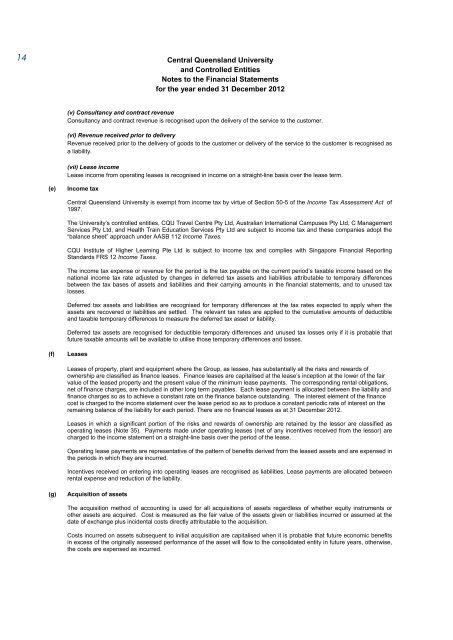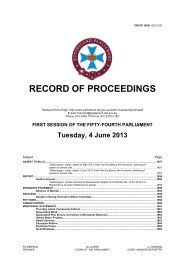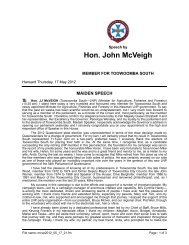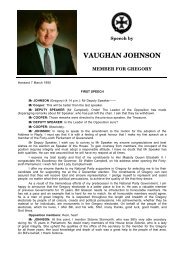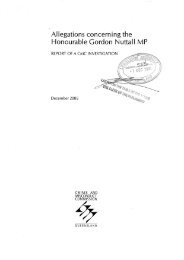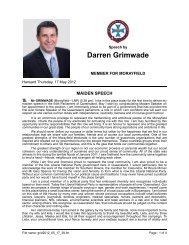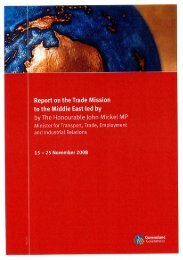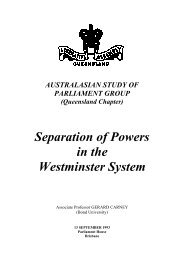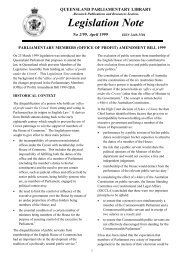CQUniversity Annual Report - Central Queensland University
CQUniversity Annual Report - Central Queensland University
CQUniversity Annual Report - Central Queensland University
You also want an ePaper? Increase the reach of your titles
YUMPU automatically turns print PDFs into web optimized ePapers that Google loves.
14<br />
<strong>Central</strong> <strong>Queensland</strong> <strong>University</strong><br />
and Controlled Entities<br />
Notes to the Financial Statements<br />
for the year ended 31 December 2012<br />
(v) Consultancy and contract revenue<br />
Consultancy and contract revenue is recognised upon the delivery of the service to the customer.<br />
(vi) Revenue received prior to delivery<br />
Revenue received prior to the delivery of goods to the customer or delivery of the service to the customer is recognised as<br />
a liability.<br />
(vii) Lease income<br />
Lease income from operating leases is recognised in income on a straight-line basis over the lease term.<br />
(e)<br />
Income tax<br />
<strong>Central</strong> <strong>Queensland</strong> <strong>University</strong> is exempt from income tax by virtue of Section 50-5 of the Income Tax Assessment Act of<br />
1997.<br />
The <strong>University</strong>’s controlled entities, CQU Travel Centre Pty Ltd, Australian International Campuses Pty Ltd, C Management<br />
Services Pty Ltd, and Health Train Education Services Pty Ltd are subject to income tax and these companies adopt the<br />
“balance sheet” approach under AASB 112 Income Taxes.<br />
CQU Institute of Higher Learning Pte Ltd is subject to income tax and complies with Singapore Financial <strong>Report</strong>ing<br />
Standards FRS 12 Income Taxes.<br />
The income tax expense or revenue for the period is the tax payable on the current period’s taxable income based on the<br />
national income tax rate adjusted by changes in deferred tax assets and liabilities attributable to temporary differences<br />
between the tax bases of assets and liabilities and their carrying amounts in the financial statements, and to unused tax<br />
losses.<br />
Deferred tax assets and liabilities are recognised for temporary differences at the tax rates expected to apply when the<br />
assets are recovered or liabilities are settled. The relevant tax rates are applied to the cumulative amounts of deductible<br />
and taxable temporary differences to measure the deferred tax asset or liability.<br />
Deferred tax assets are recognised for deductible temporary differences and unused tax losses only if it is probable that<br />
future taxable amounts will be available to utilise those temporary differences and losses.<br />
(f)<br />
Leases<br />
Leases of property, plant and equipment where the Group, as lessee, has substantially all the risks and rewards of<br />
ownership are classified as finance leases. Finance leases are capitalised at the lease’s inception at the lower of the fair<br />
value of the leased property and the present value of the minimum lease payments. The corresponding rental obligations,<br />
net of finance charges, are included in other long term payables. Each lease payment is allocated between the liability and<br />
finance charges so as to achieve a constant rate on the finance balance outstanding. The interest element of the finance<br />
cost is charged to the income statement over the lease period so as to produce a constant periodic rate of interest on the<br />
remaining balance of the liability for each period. There are no financial leases as at 31 December 2012.<br />
Leases in which a significant portion of the risks and rewards of ownership are retained by the lessor are classified as<br />
operating leases (Note 35). Payments made under operating leases (net of any incentives received from the lessor) are<br />
charged to the income statement on a straight-line basis over the period of the lease.<br />
Operating lease payments are representative of the pattern of benefits derived from the leased assets and are expensed in<br />
the periods in which they are incurred.<br />
Incentives received on entering into operating leases are recognised as liabilities. Lease payments are allocated between<br />
rental expense and reduction of the liability.<br />
(g)<br />
Acquisition of assets<br />
The acquisition method of accounting is used for all acquisitions of assets regardless of whether equity instruments or<br />
other assets are acquired. Cost is measured as the fair value of the assets given or liabilities incurred or assumed at the<br />
date of exchange plus incidental costs directly attributable to the acquisition.<br />
Costs incurred on assets subsequent to initial acquisition are capitalised when it is probable that future economic benefits<br />
in excess of the originally assessed performance of the asset will flow to the consolidated entity in future years, otherwise,<br />
the costs are expensed as incurred.


